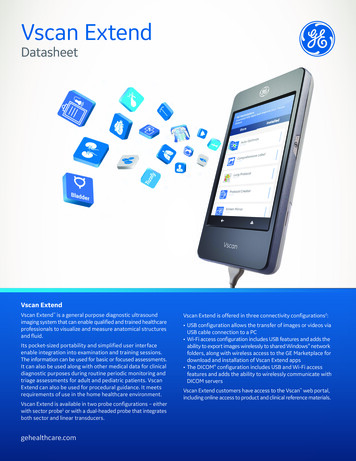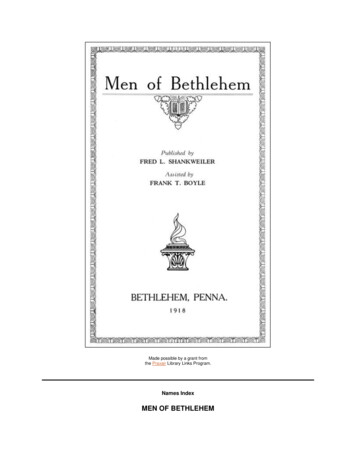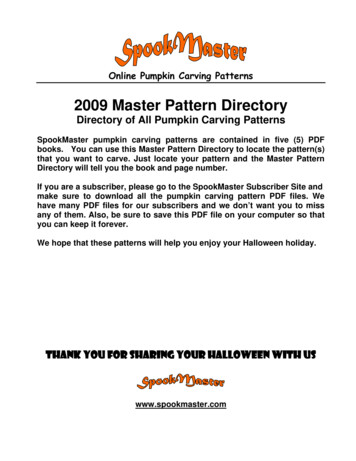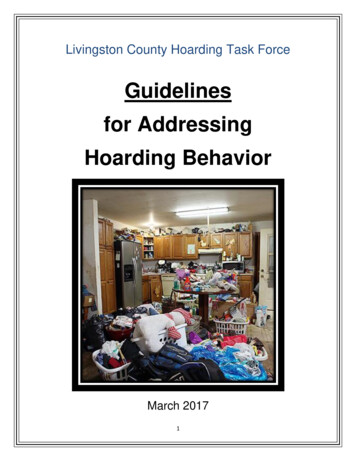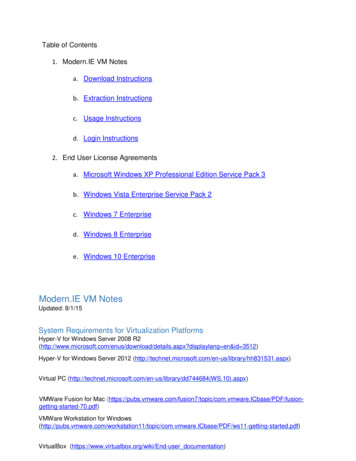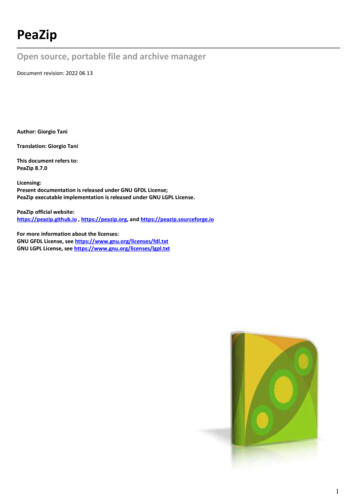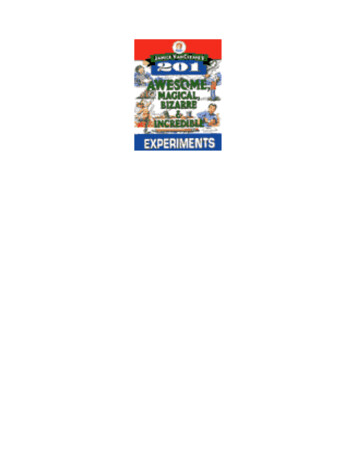
Transcription
Page iJanice VanCleave's201 Awesome, Magical, Bizarre, and Incredible Experiments
Page iiOther Books by Janice VanCleaveScience for Every Kid SeriesJanice VanCleave's Astronomy for Every KidJanice VanCleave's Biology for Every KidJanice VanCleave's Chemistry for Every KidJanice VanCleave's Dinosaurs for Every KidJanice VanCleave's Earth Science for Every KidJanice VanCleave's Ecology for Every KidJanice VanCleave's Geography for Every KidJanice VanCleave's Geometry for Every KidJanice VanCleave's The Human Body for Every KidJanice VanCleave's Math for Every KidJanice VanCleave's Oceans for Every KidJanice VanCleave's Physics for Every KidSpectacular Science Projects SeriesJanice VanCleave's AnimalsJanice VanCleave's EarthquakesJanice VanCleave's ElectricityJanice VanCleave's GravityJanice VanCleave's MachinesJanice VanCleave's MagnetsJanice VanCleave's Microscopes and Magnifying LensesJanice VanCleave's MoleculesJanice VanCleave's Rocks and MineralsJanice VanCleave's VolcanoesJanice VanCleave's WeatherJanice VanCleave's 200 Gooey, Slippery, Slimy, Weird, and Fun ExperimentsJanice VanCleave's 202 Oozing, Bubbling, Dripping, and Bouncing Experiments
Page iiiJanice VanCleave's201 Awesome, Magical, Bizarre, and Incredible Experiments
Page ivThis book is dedicated to three special people who havegiven me much encouragement—to my friends,Jim, Nancy, and Matthew LandThis text is printed on acid-free paper.Copyright 1994 by John Wiley & Sons, Inc.All rights reserved. Published simultaneously in Canada.Reproduction or translation of any part of this work beyond that permitted by Section 107 or 108 of the1976 United States Copyright Act without the permission of the copyright owner is unlawful. Requestsfor permission or further information should be addressed to the Permissions Department, John Wiley& Sons, Inc.The publisher and the author have made every reasonable effort to insure that the experiments andactivities in this book are safe when conducted as instructed but assume no responsibility for anydamage caused or sustained while performing the experiments or activities in this book. Parents,guardians, and/or teachers should supervise young readers who undertake the experiments and activitiesin this book.Library of Congress Cataloging-in-Publication Data:VanCleave, Janice.Janice VanCleave's 201 awesome, magical, bizarre, and incredible experiments / byJanice VanCleave.pcm.Includes index.ISBN 0-471-31011-5 (pbk. : alk. paper)1. Science—Experiments—Juvenile literature. [1. Science—Experiments. 2. Scientific recreations. 3. Experiments.]I. Title. II. Title: Two hundred and one awesome, magical, bizarre, andincredible ed in the United States of America10 9
Page vIntroductionThis book is a collection of science experiments designed to show you that science is more than a list offacts—science is fun! The 201 experiments in the book take science out of the laboratory and put it intoyour daily life.Science is a way of solving problems and discovering why things happen the way they do. How does abattery work? Why is Venus so hot? How can a frog build a nest in a tree? You'll find the answers tothese and many other questions by doing the experiments in this book.The experiments cover five different fields of science: Astronomy The study of the planet we live on—Earth—and all our neighbors in space. Biology The study of the way living organisms behave and interact. Chemistry The study of the way materials are put together and their behavior under differentconditions. Earth Science The study of the unique habitat that all known living creatures share—the Earth. Physics The study of energy and matter and the relationship between them.The ExperimentsScientists identify a problem, or an event, and seek solutions, or explanations, through research andexperimentation. A goal of this book is to guide you through the steps necessary to successfullycomplete a science experiment and to teach you the best method of solving problems and discoveringanswers.1. Purpose: The basic goals for the experiment.2. Materials: A list of necessary supplies.3. Procedure: Step-by-step instructions on how to perform the experiment.4. Results: An explanation stating exactly what is expected to happen. This is an immediate learningtool. If the expected results are achieved, the experimenter has an immediate positive reinforcement. Anerror is also quickly recognized, and the need to start over or make corrections is readily apparent.5. Why? An explanation of why the results were achieved is described in terms that are understandableto the reader who may not be familiar with scientific terms. When a new term is introduced andexplained, it appears in bold type; these terms can also be found in the Glossary.You will be rewarded with successful experiments if you read an experiment carefully, follow each stepin order, and do not substitute materials.
Page viGeneral Instructions1. Read first. Read each experiment completely before starting.2. Collect needed supplies. You will experience less frustration and more fun if all the necessarymaterials for the experiments are ready for instant use. You lose your train of thought when you have tostop and search for supplies.3. Experiment. Follow each step very carefully, never skip steps, and do not add your own. Safety is ofthe utmost importance, and by reading the experiment before starting, then following the instructionsexactly, you can feel confident that no unexpected results will occur.4. Observe. If your results are not the same as described in the experiment, carefully read theinstructions, and start over from the first step.MeasurementsMeasuring quantities described in this book are intended to be those commonly used in every kitchen.When specific amounts are given, you need to use a measuring instrument closest to the describedamount. The quantities listed are not critical, and a variation of very small amounts more or less will notalter the results. Approximate metric equivalents are given in parentheses.
Page viiContentsIntroductionvI. Astronomy1. Cooler22. Shaded23. Cover Up34. Thick35. Hot Box46. Sun Prints47. Hot58. Charged59. See Through610. Spinner611. On the Move712. Speedy713. Expanding814. Balancing Point815. Lifter916. In and Out917. Same Place10
18. Attractive1019. Free Movers1120. Radiate1121. Blackout1222. Swirls1223. Clock Compass1324. Mirage1325. Slanted1426. Distortion1427. Sky Path1528. Blasters1529. Changes1630. Reflector1631. Sender1732. Spreader1733. Hazy1834. Unequal1835. Burn Out!1936. Silhouette1937. Star Chart2038. How Far?2039. Details21
40. Streamers21II. Biology41. Water Flow2442. Hard to Freeze2443. Food Producers2544. Desert Plants2545. Baby Bean2646. Lights Out2647. Cuttings2748. Eyes Up2749. Algae Growth2850. Compass Plant2851. Coconut Cultures2952. Dippers2953. Flashers3054. Telegraph Lines3055. Flip-Flop3156. Belly Up3157. Blending3258. Ground Temperature3259. Foamy Nests3360. Oily Feathers33
61. Tangled3462. Pollution3463. Naked Egg3564. Shrinking Egg3565. Fooling Your Tongue3666. Trickery3667. Wagon Wheel3768. Blinking3769. Vanishing Ball3870. Water Drop Lens3871. Night Vision3972. Sound and Direction3973. Change in Pitch4074. Fingerprints4075. Tendon Action4176. Lung Capacity4177. Rubbed Off4278. How Do You Feel?4279. Spinning4380. Change of Pattern43III. Chemistry81. What's Inside?46
82. An Empty Sack?4683. Not at the Same Time4784. Dry Paper4785. How Much?4886. Where Did It Go?4887. Sinker4988. Tug of War4989. Over the Rim5090. Attractive Streams5091. Magic Solution5192. Spheres of Oil5193. Bubbler5294. Risers5295. Pop Cork5396. Drinkable Iron5397. Sticky Sand54
Page viii98. Magnesium Milk?5499. Testing for Starch55100. Limestone Deposits55101. A Different Form56102. Hard Water56103. Colder Water57104. Growing Ice57105. Needles58106. Lace58107. Soakers59108. Streamers of Color59109. Speedy Soup60110. Falling Snow60111. Strengths?61112. Layering61113. Spinning62114. Spicy Perfume62115. Smoke Rings63116. Melt Down63117. Phenol Who?64118. Pink!64
119. Basic Cleaner65120. Neutral65IV. Earth Science121. Tilt68122. Rotation68123. Deposits69124. Splitter69125. Spoon Pen70126. Sampler70127. Sinkers71128. Prints71129. Rub-A-Dub72130. Stretch72131. Flowing Ice73132. Spurt73133. Rusty Rock74134. Rub Away74135. Break Down75136. Pile Up75137. Shake-Up76138. Rock Bridge76139. Tip77
140. Push Up77141. Increasing78142. Up Draft78143. Speedy79144. Which Way?79145. Wet Bulb80146. Soggy80147. Dew Point81148. Cooling81149. Frosty82150. Drops82151. Bigger83152. Rising Drops83153. Floating Flakes84154. Low Pressure84155. Divers85156. Bang!85157. Curls86158. Wave Action86159. Up and Down87160. Mixer87V. Physics
161. Spoon Bell90162. Humming Glass90163. Twang91164. Bottle Organ91165. Cold Foot92166. Expando92167. Straight93168. See Through93169. Rosy Skin94170. Waves94171. Pepper Run95172. Air Car95173. Roller96174. Energy Change96175. Wind Brake97176. Bonk!97177. Snap!98178. Plop!98179. Crash!99180. Spool Racer99181. Spinner100182. Toothy100
183. Wedge101184. Lifter101185. Ramp102186. Upward102187. Super Straw103188. Off Target103189. Shape Up104190. Breakthrough104191. Bigger105192. Floating Needle105193. Glider106194. Magnetic Strength106195. Puller107196. Swinger107197. Fly Away108198. Glow108199. Tinkle109200. Galvanometer109201. Battery110Glossary111Index115
Page 1I—Astronomy
Page 21—CoolerPurposeTo determine how color affects a planet's surface temperature.Materialsscissorsconstruction paper (1 piece white and 1 piece black)2 empty, metal, food cans, same sizeCAUTION: Be sure rims are not jagged. They might cut your hands.transparent tape2 thermometersrulerdesk lampProcedure Cut the white and black construction paper to fit around the outside of the cans, much as the can labeldoes. Secure one piece of paper to each can with tape. Place one thermometer inside each can. Read and record the temperature on both thermometers. Position both cans about 12 inches (30 cm) from the lamp. Turn the lamp on. Read and record the temperature on both thermometers after 10 minutes.ResultsThe temperature is much higher in the can covered with black paper.Why?The dark paper absorbs more light waves than the white paper. The white paper is cooler because itreflects more of the light waves than the black paper. The absorption of the light waves increases thetemperature of a material. In the same way, the lighter the surface material on a planet, the less lightenergy the planet's surface absorbs and the cooler is its surface.
2—ShadedPurposeTo demonstrate how a planet's surface temperature can vary.Materials2 thermometersProcedure Read and record the temperature on both thermometers. Place one thermometer on the ground in the shade of a tree or other large structure. Place the second thermometer on the ground, but in direct sunlight.NOTE: It is important that both thermometers be placed on the same type of surface (grass works well). Read and record the temperature on both thermometers after 20 minutes.ResultsThe temperature on the surface in the shade is lower than the same surface in direct sunlight.Why?The tree or large structure blocks some of the light rays, producing a shaded area on the ground. Thisprotected surface area is cooler due to the decrease in light energy received. The same type of surface indirect sunlight receives more light energy and becomes hotter. In the same way, the temperature ofplanet surfaces can vary depending on whether the landscape has large structures to provide shade.
Page 33—Cover UpPurposeTo determine why Mercury does not cause an eclipse.Materialsdesk lampProcedure Stand about 2 yards (2 m) from the desk lamp. Close your right eye. Hold your left thumb at arm's length in front of your left eye and in front of the lamp. Slowly move your thumb toward your face until it is directly in front of your open eye.ResultsThe farther your thumb is from your eye, the smaller your thumb appears and the more of the lamp yousee.Why?Your thumb blocked the light moving from the lamp toward your eye. The closer your thumb is to yourface, the more light it blocks. Because Mercury is very close to the Sun, it blocks only a small portionof the Sun's light, as did your thumb when held close to the lamp. The shadow made by Mercury is sosmall that it does not spread out enough to fall on the Earth, but lands in space. For this reason, Mercurydoes not cause a solar eclipse (blocking of some of the sunlight from parts of the Earth).
4—ThickPurposeTo determine why Venus' atmosphere is so hard to see through.Materialsflashlightwax paperProcedure Turn the flashlight on and place it on the edge of a table. Stand about 2 yards (2 m) from the table. Face the light and observe its brightness. Hold the sheet of wax paper in front of your face. Look through the wax paper at the light.ResultsThe light looks blurred through the paper.Why?
The light rays bend and bounce off the wax paper. This is similar to the way sunlight bends andbounces off the thick clouds that surround Venus, which are not particularly dark, just very thick. Intheir thickest part, the visibility is about 0.6 miles (1 km) or less. This low visibility would result in theclosing of most airports on Earth.
Page 45—Hot BoxPurposeTo determine why Venus is so hot.Materials2 thermometers1 jar with lid (tall enough to hold one of the thermometers)Procedure Put one thermometer inside the jar and close the lid. Place the second thermometer and the jar near a window in direct sunlight. Record the temperature on both thermometers after 20 minutes.ResultsThe temperature inside the closed jar is higher than outside the jar.Why?The glass jar is used to simulate the trapping of infrared light waves by gasses in the atmosphere aroundplanets. The thick atmosphere around Venus allows short wave radiation through, but blocks long waveradiation. The trapped long wave infrared light warms the planet's surface to about 800 degreesFahrenheit (427 C).
6—Sun PrintsPurposeTo determine what might cause Jupiter's colored clouds.Materialsscissorscardboarddouble-sided tapephotographic paper (This can be purchased at a photography store, or ask your local newspaper or highschool photography club for a sheet of outdated photographic paper. Keep it out of the sunlight.)Procedure Cut a heart shape out of the cardboard. In a semidarkened room, use the double-sided tape to stick the heart to the glossy side of thephotographic paper. Take the paper outside and allow the Sun to shine directly on the paper for 1 minute. Return to the darkened room and take the paper heart off the photographic paper.ResultsThe photographic paper is unchanged under the cardboard. A light-colored, heart-shaped design is
surrounded by a dark background.Why?The photographic paper turns dark only where light hits it. This change is because the light activates themolecules on the glossy surface of the paper. Scientists think that the colors in Jupiter's atmosphere maycome from chemicals in the clouds that change color because of lightning or that the Sun changes thecolors as it did the special light-sensitive photographic paper.
Page 57—HotPurposeTo determine if conservation of energy applies to friction between molecules in a dense atmosphere.Materialsyour handsProcedure Place your palms together. Quickly rub your dry hands back and forth several times.ResultsYour dry hands feel hot when rubbed together.Why?Friction between your hands produces heat energy, as does the friction between any moving objects.Friction is a force that tends to stop objects sliding past each other. The closer and faster the objects inmotion are, the greater is the heat. This would make one think that the dense atmosphere aroundplanets such as Jupiter would cause an increase in the surface temperature. The winds around Jupiterblow in excess of 800 miles (1,280 km) per hour. The atmospheric gases are constantly being rubbedtogether, but the temperature on the planet does not increase continuously. The temperature on theplanet Jupiter remains constant due to conservation of energy (heat gained by one substance is equal tothe heat lost by some other substance).8—
ChargedPurposeTo determine why lightning continually flashes on Jupiter.Materialsscissorsrulerthin sheet of plastic (plastic report cover)wool cloth (use any 100 percent wool coat, scarf, sweater, etc.)Procedure Cut a plastic strip about 2 8 inches (5 20 cm). In a dark room, hold the end of the plastic strip. Wrap the wool cloth around the plastic, then quicklypull the plastic through the cloth. Repeat this 5 or 6 times. Observe the cloth as you pull the plastic through it.ResultsA bluish light is seen in the folds of cloth that touch the plastic.Why?Electrons are negative particles that spin around a positively charged nucleus of an atom. Some ofthese electrons are rubbed off the wool and onto the plastic strip. The wool becomes positively chargedand the plastic negatively charged. When the electrons leap from the plastic back to the wool, anelectric spark is created. Flashes of light are continually seen through the clouds that swirl aroundJupiter. The molecules in the atmosphere are briskly rubbed together because of the winds that blowup to 800 miles (1,280 km) per hour. The rubbing of the molecules in the atmosphere, like the rubbingof the wool cloth on the plastic, can result in electric sparks.
Page 69—See ThroughPurposeTo determine how Saturn can be seen through its rings.Materialsscissorsblack markingpenrulerstraight penwhite posterboardpencilglueadult helperProcedure Cut 3 strips from the poster board that are each 1 6 inches (2.5 15 cm). Evenly space the strips so that their centers cross. Glue the centers of the strips together. Use the marking pen to make two marks across the ends of each strip. Start the first mark 1/2 inch (1cm) from the end of the strip and make the second mark 1 inch (2.5 cm) from the end. Ask an adult to insert the pin through the center of the strips. Use the pin to enlarge the hole so that thepaper blades easily spin. Then stick the end of the pin in a pencil eraser. Spin the paper blades. Observe the spinning blades.ResultsTwo black rings are seen, but you can see through the spinning blades.Why?Your eyes blend the color on the paper strips as they spin, producing what appears to be solid rings. Therings around Saturn are made of chunks of ice and rock. Their movement makes them appear to be acontinuous surface as does the movement of the black marks on the spinning paper.
10—SpinnerPurposeTo determine why planets move smoothly around the Sun.Materials10-inch (25-cm)diameter cake panscissorsrulerpencilheavy, thickstringsheet of paper4 large paperclipscardboardadult helperProcedure Use the cake pan to draw a circle on the paper and the cardboard. Cut the circles out. Fold the paper in half twice to find the center of the circle. Ask an adult to lay the paper over the cardboard circle and make a hole through the center of both
circles with the point of a pencil. Discard the paper. Cut a 1-yard (1-m) length of string. Thread one end of the string through the hole in the cardboard circle, and tie a knot on the other sideto keep it from pulling back through. Evenly space the 4 paper clips around the outer rim of the cardboard circle or disk. Hold the end of the string and swing the disk back and forth. Continue to hold the end of the string while you give the disk a quick spin toward you, then swing itas before.ResultsThe disk flops around when merely moved around on the string, but when spun, it rotates in the plane inwhich it was originally spun.Why?The cardboard disk acts like a gyroscope, a kind of top whose axis always points in the same directionwhile spinning. The planets spin on their axis as they rotate around the Sun. This keeps them turning inthe plane in which they were started just as the disk does.
Page 711—On the MovePurposeTo determine why planets continue to move.Materialsround cake panpencil1 sheet construction paperscissors1 marbleProcedure Use the cake pan to trace a circle on the paper. Cut the circle out. Place the pan on a flat surface. Lay the paper inside the pan and place the marble on top of the paper. Thump the marble so that it rolls around next to the wall of the pan. Remove the paper from the pan. Again, thump the marble so that it rolls around next to the wall of the pan.ResultsThe marble rolls in a circular path. It rolls farther and faster without the paper lining in the pan.Why?Inertia is the resistance that all objects have to any change in motion. Inertia causes stationary objectsto remain at rest and moving objects to continue to move in a straight line, unless some force acts onthem. The marble stopped moving more quickly in the paper-lined pan because of friction. When thefriction between the pan and the marble was reduced, the marble rolled for a longer time. The planetscontinue to move around the Sun because their movement through space is not restricted by friction.
12—SpeedyPurposeTo determine the effect of distance on the orbiting speed of planets.Materials1 metal washer1-yard (1-m) piece of stringProcedureNOTE: This activity is to be performed in an open, outside area away from other people. Tie the washer to the end of the 1-yard (1-m) length of string. Hold the end of the string and extend your arm outward. Swing your arm around so that the washer moves in a circular path beside your body. Spin the washer at the slowest speed necessary to keep the string taut. Hold the string in the center and spin the washer at the slowest speed necessary to keep the string taut. Hold the string about 10 inches (25 cm) from the washer and spin as before.ResultsAs the length of the string decreases, the washer must be spun around more times in order to keep thestring taut.Why?The washer seems to move sluggishly around in its circular path when attached to a long string, while
on a shorter string, it zips around quickly. This is also true about planets, which differ in their distancefrom the Sun. As the planet's distance from the Sun increases, the pull toward the Sun, called gravity(the force that pulls celestial bodies toward each other), decreases. With less pull toward the Sun, theorbiting speed of the planet decreases. Mercury, the closest planet to the Sun, has the fastest orbitingspeed and Pluto, the furthermost planet, has the slowest orbiting speed. (Twirling the washer on thestring is not a true simulation of how planets move around the Sun, because planets are not attached tothe Sun by a cord and do not move in a circular path.)
Page 813—ExpandingPurposeTo demonstrate how galaxies may be moving.Materials9-inch (23-cm) round balloonblack marking penmirrorProcedure Inflate the balloon so that it is about as large as an apple. Use the marking pen to randomly make about 20 dots on the balloon. Stand in front of a mirror and observe the dots as you inflate the balloon.ResultsThe dots move away from each other. Some seem to move farther than others, but no dots get closertogether.Why?Astronomers believe that the galaxies (large systems of stars) are moving away from each othersimilarly to the way the dots on the balloon move. Not all the galaxies are moving away from us at thesame rate. In 1929, Dr. Edwin Hubble discovered that the farther away a galaxy is, the faster it seems tobe moving away from us. Since no two galaxies seem to be getting closer as they move, scientistsbelieve the universe is expanding.14—Balancing Point
PurposeTo demonstrate the position of the Earth's ing clayProcedure Cut the 12-inch (30-cm) length of string. Tie the string about 1 inch (3 cm) from the end of the pencil. Make a ball of clay, about the size of a lemon. Stick the clay ball on the end of the pencil with the string. Mold the clay around the string so that the string is barely inside the edge of the clay ball. Add a grape-size piece of clay to the opposite end of the pencil. Hold the end of the string and add small pieces of clay to the end of the pencil until the pencilbalances horizontally.ResultsThe pencil hangs in a horizontal position.Why?The center of gravity (balancing point) of the Earth-Moon system is called the barycenter. Thebarycenter is about 2,720 miles (4,352 km) beneath the Earth's surface on the side of Earth facing theMoon, and it is the point at which the Earth-Moon system moves around the Sun. The string representsthe Earth's barycenter on the Earth-Moon model.
Page 915—LifterPurposeTo demonstrate how the atmosphere affects falling objects.Materialspaperbook larger than the paperProcedure Position the paper on top of the book so that half of the paper is hanging over the edge of the book. Drop the book and paper from a waist-high position. Observe the paper and book as they fall and strike the ground.ResultsThe paper leaves the book and falls more slowly.Why?Objects push against air molecules in the Earth's atmosphere as they fall. These air molecules pushback against the falling object causing its speed to decrease. The speed of the falling book is greaterthan that of the paper because its weight (downward force due to gravity) is so much greater than theupward push of the air.
16—In and OutPurposeTo demonstrate forces that keep satellites in orbit.Materialsscissorsmaskingtapeyardstick (meterstick)thread spoolstringmetal spoonProcedure Cut 1 yard (1 m) of string. Tie one end of the string to the roll of tape. Thread the free end of the string through the hole in the spool.
Tie the spoon to the free end of the string. Stand in an open area holding the tape in one hand and the spool with your other hand. Give the spool a quick circular motion to start it spinning in a horizontal circle above your head. Release the tape and allow it to hang freely. Keep the spoon spinning by moving the thread spool in a circular motion. Observe the movement of the tape roll.ResultsThe spoon spins in a circular path with only the weight of the tape pulling on the attached string.Why?Any circling object, spoon or satellite, has a centripetal force (force directed toward the center)keeping it in its circular path. Moons that orbit planets and planets that orbit the Sun are all pulledtoward the celestial body that they orbit. Their own forward speed keeps them from being pulled intothe body that they orbit, and the centripetal force acting on the orbiting bodies keeps them from movingoff into space.
Page 1017—Same PlacePurposeTo determine why satellites appear to be stationary.Materialsrope about 3 yards (3 m) longhelperProcedure In an open area outside, use a tree or other object to represent the Earth. Ask your helper to hold one end of the rope as you hold on to the other end. Have your helper stand near the tree. Walk at a pace that keeps the rope tight and in a position so that you are in line with the same point onthe tree as your helper.ResultsThe person in the outside circle moves faster, but stays in line with the person moving in the smallerinside circle.Why?The distance around the outside of the circle is larger than the circle near the tree. A faster speed isrequired to travel around the larger circle in the same time that the person closer to the tree travelsaround the smaller circle. Geostationary Operational Environmental Satellites (GOES) are placed atabout 22,500 miles (36,000 km) above the Earth. They move at a very fast speed, which gives them anorbital period of 24 hours, the same as that of the Earth; thus, the satellites appear to remain stationaryabove the Earth. There are more than 120 geostationary satellites positioned above the Earth's equator.
18—AttractivePurposeTo simulate the solar magnetic field.Materialsbar magnet81/2 11 inch (22 28 cm) sheet of white paperiron filings (found in magnetic drawing toys sold at toy stores)small spray bottlewhite vinegarpencilProcedure Lay the magnet on a wooden table. Cover the magnet with the sheet of paper. Sprinkle iron filings over the surface of the paper. Gently tap the paper with your finger until the filings settle into a pattern. Fill the spray bottle 1/2 full with the vinegar. Spray a fine mist of vinegar over the iron filings on the paper. Allow the paper to remain undisturbed for an hour. Lift the paper and shake the iron filings into the trash.
Draw a circle in the center of the pattern left by the rusty filings and label it ''Sun."ResultsThe iron filings form curved lines around the magnet. Adding the vinegar makes the iron in the filingsrust. When the filings are shaken off, the rust leaves marks on the paper where the filings were.Why?Every magnet has an invisible magnetic field around it. This field is made up of lines of force thatattract magnetic material such as iron filings. The magnetic field of the Sun, like the bar magnet in thisexperiment, has a north and south pole. It is thought that the Sun's magnetic field may extend out of itsnorth pole to the outer limits of our solar system (the orbit of Pluto) where it bends around and returnsto the Sun's magnetic south pole.
Page 1119—Free MoversPurposeTo determine why different parts of the Sun rotate at different rates.Materials2 2-quart (2-liter) plastic soda bottlestap water1 tea bagwasher (same diameter as the bottle's mouth)paper towelduct tapeProcedure Fill one bottle 1/2 full with tap water. Open the tea bag and pour the tea leaves into the water. Cover the mouth of the bottle containing the water and tea leaves with the washer. Turn the second bottle upside down and place it on top of the washer. Use the paper towel to dry any moisture from the necks of the bottles
Other Books by Janice VanCleave Science for Every Kid Series Janice VanCleave's Astronomy for Every Kid . Janice VanCleave's 200 Gooey, Slippery, Slimy, Weird, and Fun Experiments Janice VanCleave's 202 Oozing, Bubbling, Dripping, and Bouncing Experiments. Page iii Janice VanCleave's 201 Awesome, Magical, Bizarre, and Incredible Experiments .

![March 3rd, 2017 [Manage Archive in Microsoft Outlook 2016]](/img/34/archive-outlook-2016.jpg)
